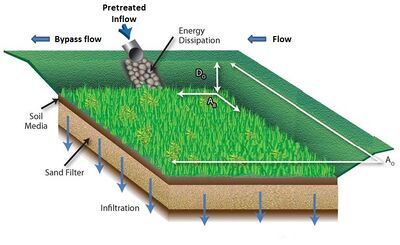
Category:Level 2 - Technical and specific topic information/infiltration

Main page for infiltration practices
Stormwater infiltration is the process by which rainfall and stormwater runoff flows into and through the subsurface soil. Stormwater infiltration occurs when rainfall lands on pervious surfaces, when runoff flows across pervious surfaces, and when runoff is collected and directed to a stormwater infiltration Best Management Practice (BMP).
Current stormwater management policies encourage, when appropriate, maximizing the infiltration of stormwater to reduce the volume of runoff discharging to surface waters. In addition to reducing runoff volume, stormwater infiltration helps reduce stormwater pollutant loading to surface waters. Many factors influence the rate and volume of stormwater infiltration, including soil and rainfall characteristics. Once stormwater infiltrates into the soil, it has the potential to enter the groundwater, become part of the subsurface flow, or be taken up by vegetation.
For the purposes of this manual, infiltration BMPs are considered BMPs without underdrains.
This page provides links to pages that address topics related to infiltration of stormwater, such as constraints on infiltration and determining infiltration rates at sites.
Pages in category "Level 2 - Technical and specific topic information/infiltration"
The following 27 pages are in this category, out of 27 total.
G
- Guidance and recommendations for conducting a higher level of engineering review for stormwater infiltration in DWSMAs and Wellhead Protection Areas
- Guidance for amending soils with rapid or high infiltration rates
- Guidance for calculator to estimate chloride loading to groundwater from infiltration
K
P
S
- Screening assessment for contamination at potential stormwater infiltration sites
- Shallow groundwater
- Shallow soils and shallow depth to bedrock
- Soils with low infiltration capacity
- Stormwater and wellhead protection
- Stormwater infiltration
- Stormwater infiltration and constraints on infiltration combined
- Stormwater infiltration and contaminated soils and groundwater
- Stormwater infiltration and groundwater mounding
- Stormwater infiltration and setback (separation) distances
- Stormwater Infiltration and soil/groundwater contamination: A guide to the Construction Stormwater Permit requirements
- Stormwater infiltration Best Management Practices
- Stormwater infiltration guidance for sites with known or high potential for soil or groundwater contamination on or off-site
- Surface water and groundwater quality impacts from stormwater infiltration
Media in category "Level 2 - Technical and specific topic information/infiltration"
The following 8 files are in this category, out of 8 total.
- Mounding scenarios expanded.xlsx ; 52 KB
This page was last edited on 13 February 2023, at 03:42.